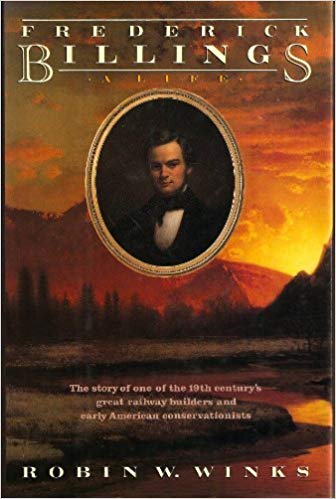New York Times junkies would have noticed an August 28, 1991, story headed “Woodstock Journal.” Reading on they discovered that the story was datelined Woodstock, Vermont, and that it reported a proposal by Laurance S. and Mary Rockefeller to donate their 531-acre Woodstock estate as a National Historical Park. Although the Rockefeller family has a generations-long tradition of adding to the national park system, the story was not one of dog bites man. The estate includes the two-centuries-old mansion that was the birthplace of George Perkins Marsh, author in 1864 of Man and Nature: Physical Geography as Modified by Human Action, which in Lewis Mumford’s frequently quoted words was “the fountainhead of the conservation movement in America.” In 1869, Marsh sold the estate—the only time it has ever been sold—to a lifelong admirer, Frederick Billings. Mary Rockefeller is Billings’ granddaughter.
Although a principal American railroad builder and pioneer conservationist, Frederick Billings has lacked a scholarly biography. Robin W. Winks, having gained permission from the Rockefeller family to consult the records in the Billings Archives, has admirably filled that gap. Before launching his railroad career, Billings sought his fortune in gold-rush California. He arrived in San Francisco in the spring of 1849 and took not to the gold fields but to law and real estate. He was the first attorney in San Francisco to hang out his shingle and was a founding partner in what became California’s principal law firm. Specializing in litigation of disputed land claims—a lucrative field in gold-rush California—Billings used his fees and his knowledge of dubious land titles to buy real estate. He also, with his partners, constructed the Montgomery Block, the city’s most attractive office complex., As soon as his increasing wealth could support the role, Billings the attorney-businessman was joined by Billings the philanthropist. Public education (especially school libraries), religion, and parks and scenic landscapes became lifelong areas of special interest. He was a major figure in both the founding of the University of California and the preservation of Yosemite Valley as, in effect, a state-run national park.
Yet Billings continued to sign himself “Frederick Billings of Woodstock,” and his California years did indeed prove only to be an extended sojourn. In the mid-1860’s he returned to the East Coast and bought into “the single greatest American corporate undertaking of the 19th century,” the Northern Pacific Railroad, becoming its largest single stockholder and president. He made two, closely related, lifesaving contributions to the railroad. In the aftermath of the Panic of 1873—largely precipitated by Jay Cooke’s mishandling of Northern Pacific finances— Billings carried through a reorganization that made survival possible. Equally crucial, he revitalized the railroad’s land office, and income from the increased land sales made the reorganization feasible. Billings’ move, therefore, from the West Coast and law to the East Coast and railroads was not a radical new departure. As Winks observes, “What Billings knew best was land law,” and “railroad companies were, in fact, land companies.” Addressing the standard question about the business giants of the Gilded Age—were they “Robber Barons” or “Industrial Statesmen”?—Winks’ answer for the railroad builders is a little bit of both. Billings, however, despite a few small warts (real estate promotion is inherently risky to the promoter’s moral health), unquestionably belongs in the second category; he is a “hero of capitalism.”
The bandwagon labeled “Pioneers of American Conservation” has in recent years become increasingly crowded. Among the old, familiar riders—^naturalists and foresters, novelists and essayists, politicians and publicists—are unfamiliar newcomers such as sportsmen and military men, artists and scientists. To this lengthening manifest Winks would add yet another name, the businessman—or at least a businessman—Frederick Billings. He showed an interest in conservation throughout his life and devoted his last years to it “almost wholly.” Yet Billings was, as Winks makes clear, a conservationist “by the light of his day.” Not only was he untroubled by such present-day questions of deep ecology as “Do rocks have rights?” but he died in 1890, before the controversy over definition that produced the conservation schism had fully developed. Hence, without much sense of inner conflict, he could be both preservationist “nature-lover” and utilitarian “wise-user.” He worked for the preservation of the natural wonders of Yosemite, served on the Vermont Forestry Commission, and demonstrated reforestation, scientific management, and sustained yield on his Woodstock estate. Yet like his mentor Marsh, Billings was in the end an intelligent manipulator of nature. In Winks’ words, “Love of landscape . . . was not enough. . . . Nature would need help.” St. Benedict, not St. Francis, was the patron saint of conservation.
Winks’ biography of Frederick Billings brings a much-needed reminder to conservatives: pioneer conservationists were not exclusively early-day, left-wing “radical environmentalists” pursuing the “hidden agenda” of destroying private enterprise. Conservation was not, and is not, inherently “anti-business,” and Billings’ life provided repeated instances of-what Winks calls “the alliance of ‘commerce and conservation.'” Rereading Marsh toward the end of his life, Billings was convinced that “conservation was the highest form of efficiency.” It is time for conservatives to regain the leadership role in the conservation movement that Billings pioneered more than a century ago.
[Frederick Billings: A Life, by Robin W. Winks (New York: Oxford University Press) 424 pp., $27.95]

Leave a Reply